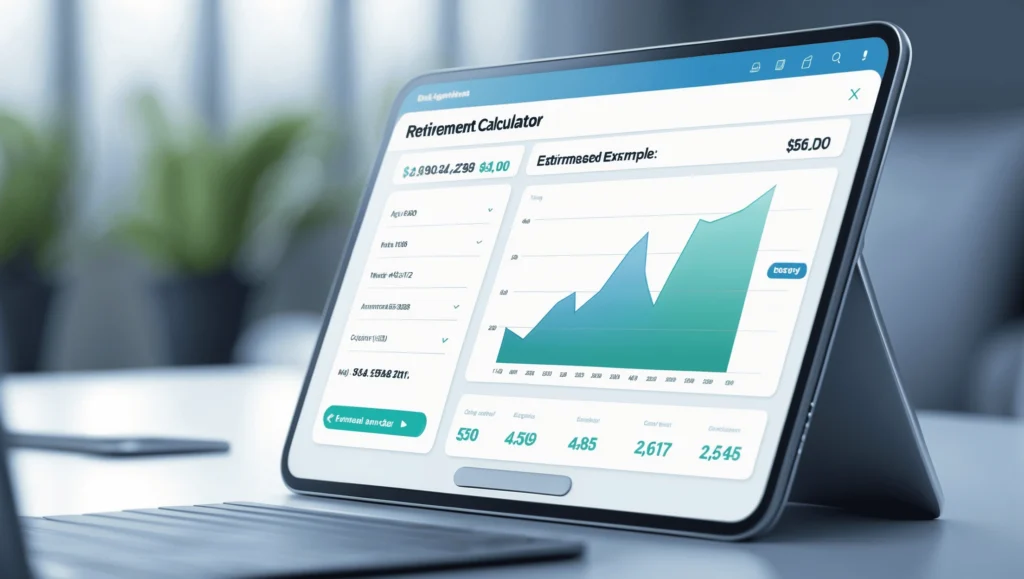Retirement planning is a critical step toward ensuring financial security and peace of mind in your later years. Retirement Planning for Beginners is an essential guide to starting early, which can offer significant benefits, such as the power of compound interest and a stress-free retirement. By taking proactive steps now, you can build a solid foundation for the future.
In this guide, we’ll cover five key steps to help you get started with retirement planning. You’ll learn how to set clear goals, assess your financial situation, explore savings options, create an investment strategy, and regularly review your plan. These practical tips are designed to make retirement planning for beginners simple and actionable.
For more tools and resources, explore Fidelity’s retirement calculators or Vanguard’s retirement tools.
Determine Your Retirement Goals
Step 1: Decide Your Desired Retirement Age
Start by identifying when you want to retire. This could be at a traditional age, like 65, or earlier if you’re aiming for financial independence. Consider factors like your health, career plans, and lifestyle goals. Knowing your retirement age gives you a clear target to plan your finances.
Step 2: Estimate Your Retirement Expenses
Think about the kind of lifestyle you want during retirement. Start with essentials like housing, healthcare, and food. Then, account for discretionary expenses such as travel, hobbies, and entertainment. Don’t forget to include inflation when estimating long-term costs. For example, healthcare costs tend to rise faster than general living expenses. Understanding these expenses is key to realistic retirement planning for beginners.
Step 3: Use a Retirement Calculator
Leverage tools like those from Fidelity or Vanguard to estimate your savings needs. Retirement calculators help you see how much you’ll need based on your desired age and lifestyle. They consider factors like your current savings, annual income, and expected investment returns. These tools can also show how consistent saving and investing can help you reach your goals.
For more details on retirement calculators, visit resources like Fidelity’s Retirement Planning Tools or Vanguard’s Retirement Calculator.
By setting clear goals, estimating expenses, and using calculators, you can create a roadmap for your financial future. For more guidance, check out our full guide on Retirement Planning for Beginners.

Assess Your Current Financial Situation
Calculate Your Current Savings and Investments
Begin by assessing your existing savings and investments. Take note of any balances in savings accounts, retirement accounts like 401(k)s or IRAs, and taxable investment accounts. Understanding your current financial position is a critical first step in retirement planning for beginners.
Analyze Your Current Income and Expenses
Review your monthly income and list all sources, such as salaries, side hustles, or rental income. Then, track your monthly expenses to see where your money goes. Divide them into essential categories like housing, utilities, groceries, and discretionary spending like dining out or entertainment. This analysis helps you identify opportunities to save more for your retirement.
Identify Debt and Create a Repayment Plan
Make a list of all your existing debts, including credit cards, student loans, car loans, and mortgages. Prioritize high-interest debt first, as it can significantly affect your ability to save. Consider using strategies like the snowball or avalanche method to pay down debts efficiently. Once your high-interest debts are under control, redirect those funds toward retirement savings.
Understanding where you stand financially is essential to crafting a realistic retirement plan. By calculating your savings, analyzing your cash flow, and addressing debt, you’ll build a solid foundation for your retirement goals. If you’re just starting, tools like retirement calculators from trusted sources (e.g., Fidelity or Vanguard) can offer valuable guidance.
For more resources on retirement planning for beginners, visit reliable sites like Fidelity or Vanguard.
Explore Retirement Savings Options
Understand Different Retirement Accounts
Retirement planning for beginners starts with understanding the types of accounts available. A 401(k) is an employer-sponsored plan offering tax advantages, often with matching contributions. An IRA (Individual Retirement Account) allows you to save with tax benefits, while a Roth IRA offers tax-free withdrawals in retirement. If you work for a nonprofit, a 403(b) plan is similar to a 401(k) and provides valuable savings opportunities.
Maximize Employer Matching Contributions
If your employer offers matching contributions to your 401(k), take full advantage. This match is essentially free money that can significantly boost your retirement savings. For example, if your employer matches up to 5% of your salary, contribute at least that amount to maximize the benefit. Over time, this can compound and grow into a substantial nest egg.
Consider Utilizing a Roth IRA
A Roth IRA is an excellent option for long-term retirement planning, particularly for beginners. Contributions to a Roth IRA are made with after-tax income, and qualified withdrawals in retirement are tax-free. This account is especially beneficial if you anticipate being in a higher tax bracket in the future. To get started, research Roth IRA providers like Vanguard or Fidelity, which offer low fees and robust investment options.
For more details on choosing the right retirement account, check resources like Investopedia’s Guide to Retirement Accounts or visit the IRS website for official guidance.
Effective retirement planning requires understanding your options, maximizing opportunities like employer matching, and strategically selecting accounts like a Roth IRA to secure your financial future.

Develop an Investment Strategy
When planning for retirement, one of the most important steps is to create an investment strategy that aligns with your goals. This involves understanding your risk tolerance, deciding on an appropriate asset allocation, and choosing the right investment options.
Assess Your Risk Tolerance and Investment Horizon
The first step in developing an investment strategy is determining your risk tolerance. Risk tolerance refers to how much risk you are willing to take with your investments. Some individuals are comfortable with high-risk investments, seeking higher returns, while others prefer a more conservative approach to protect their savings. Understanding your personal comfort level with risk is crucial in building a balanced portfolio that suits you.
In addition, consider your investment time horizon. This is the length of time you expect to hold your investments before needing the money. If you are in your 20s or 30s, you might have a long time to invest, allowing you to take on more risk. However, if retirement is closer, you may want to reduce your risk and prioritize stability to protect your savings. Evaluating both risk tolerance and time horizon will help guide your investment decisions.
Choose the Right Asset Allocation
Next, you’ll need to consider your asset allocation strategy. Asset allocation refers to how your investments are distributed across different types of assets, such as stocks, bonds, and real estate. Stocks offer higher potential returns but also come with higher risk. Bonds tend to be more stable but offer lower returns. Real estate can provide income and long-term growth potential.
A well-diversified portfolio that includes a mix of stocks, bonds, and real estate can help you balance risk and return. The right asset allocation depends on your risk tolerance, financial goals, and time horizon. For example, a younger investor might allocate more toward stocks for growth, while someone nearing retirement might choose more bonds for stability. Reevaluate your allocation regularly to ensure it aligns with your changing needs.
Explore Investment Options
Finally, explore the various investment options available to you. Mutual funds, ETFs (exchange-traded funds), and index funds are popular choices for many retirement savers. Mutual funds pool money from multiple investors to invest in a diversified portfolio of stocks, bonds, or other securities. They offer professional management but come with management fees. ETFs are similar to mutual funds but trade like individual stocks on the stock exchange. They usually have lower fees and are more flexible.
Index funds are a type of mutual fund or ETF that aims to replicate the performance of a specific market index, such as the S&P 500. They offer low fees and broad market exposure, making them a cost-effective option for many investors. Each of these options offers different benefits, so it’s important to research and select those that align with your financial goals and risk tolerance.
By assessing your risk tolerance, selecting an appropriate asset allocation, and exploring investment options, you can build an investment strategy that supports your retirement planning. Remember, consistency is key. Regularly monitor your investments and make adjustments as needed to stay on track. For more guidance on retirement planning, consider consulting resources like Fidelity or Vanguard.
Review and Adjust Your Retirement Plan Regularly
1. Review Your Plan Annually
Retirement planning for beginners should include a regular review. Set aside time each year to assess your progress. This helps you stay on track with your goals. During your review, check if your savings are growing as expected. If you’re falling short, consider increasing your contributions or adjusting your investment strategy. Life changes, so your plan should be flexible enough to accommodate new circumstances.
2. Rebalance Your Investment Portfolio
Your investment portfolio needs periodic rebalancing. Over time, market fluctuations can shift your asset allocation. This means your portfolio may no longer match your desired risk level. Rebalancing ensures you maintain a mix of assets that aligns with your retirement goals. For example, if stocks perform well, you may need to sell some of your stock holdings and invest in bonds or other assets. Doing this regularly helps keep your investments in line with your risk tolerance and time horizon.
3. Stay Informed About Changes in Tax Laws and Retirement Regulations
Retirement planning isn’t static. Tax laws and retirement regulations often change, and these changes can impact your strategy. Keep an eye on updates from reliable sources like the IRS or your financial advisor. Tax advantages, contribution limits, and retirement account rules can evolve, affecting how you save and invest for retirement. By staying informed, you can adjust your plan accordingly to maximize your retirement savings.
Regular reviews, rebalancing, and staying up-to-date with regulations are essential for effective retirement planning. These practices ensure that you’re on the right path to meeting your retirement goals.
For more tips on managing your retirement, consider visiting resources like Fidelity’s Retirement Planning Tools or IRS Retirement Plans.

Conclusion
To wrap up, retirement planning involves several key steps. First, set clear retirement goals by determining your desired retirement age and estimating future expenses. Next, assess your current financial situation, including savings, income, and debt. Then, explore retirement savings options like a 401(k), IRA, or Roth IRA. After that, develop an investment strategy based on your risk tolerance and goals. Finally, review and adjust your plan regularly to stay on track.
Consistency and discipline are essential for successful retirement planning. The more consistently you save and invest, the better your chances of achieving your goals.
If you’re unsure where to start or need personalized advice, consider consulting a financial advisor. You can also take advantage of resources offered by organizations like AARP or the Social Security Administration. They can help guide you through the process and offer valuable insights tailored to your needs.







Leave a Reply